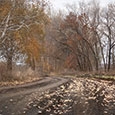At this time of year, students are busy with midterms, it is a few months into most orchestral seasons, and there is a sameness as the days and weeks go by. The days are getting shorter, the weather gets colder, and more time is spent inside. All of these things contribute to the fall flute blahs. Getting your students (and yourself) out of the slump can take a determined effort.

Warmup
Most musicians have a perfect warmup routine that they intend to do daily. Unfortunately, things happen and no day offers the luxury to do everything as planned. Take a look at your warmup routine. Ask what is really necessary to keep your playing topnotch. Make a new list. Then with the things that remain look for ways to practice them in a different way. For example, scales are usually played ascending and then descending. Have you ever played them descending and then ascending? This is an excellent exercise to work on changing the air speed from a faster to slower and then faster again. This idea works well on thirds, sixths, arpeggios, and seventh chords. Make a template of tempos, dynamics, and articulation patterns, so each day offers a new challenge. Or pick a composer and play the material in the style of that composer. It is a challenge to play like Mozart one day and Wagner the next.
Etudes
Find a new etude book. Denis Bouriakov, principal flute in the Los Angeles Philharmonic, suggested in his July/August Flute Talk interview that he likes the Etudes de Concert by Vladimir Tsybin (1877-1949). Tsybin, who is considered to be the founder of the Russian flute school, taught at the Moscow Conservatory between 1923 and 1949. These challenging etudes for flute and piano may be downloaded for free at www.imslp.org. Every three years in Moscow there is a flute competition that bears Tsybin’s name.
Borrow some etudes from other instruments, such as the 48 Studies for Oboe, Op. 31 by Franz Wilhelm Ferling (1796-1874). They were published in 1837 and written in a Romantic style. The etudes are paired by tempo and alternate between fast and slow. The slow etudes offer challenges in counting in a subdivided manner. Ferling was a German oboist, composer and clarinetist. Saxophone players have borrowed these works for years with great success, and they work well on the flute too.
Beginning Book or Treatise
Start at the beginning of the book pretending you are playing these exercises for the first time. Try to play as well as you can paying special attention to the attacks and releases of the notes. Read all of the instructions carefully and apply them in your practice. Use the tuner and try to keep the needle still.
Solo Repertoire
Select music for a 30-minute program to present at a senior citizen center. A suggested program could include one of the twelve Telemann Fantasies for Flute or, if you have played these too much, consider transcribing one of his Twelve Fantasies for Violin (1735). These works are strong musically and offer opportunities to work on lyric playing, ornamentation and playing fast movements in a dance style with some two-part voicings.
Another choice might be the Sonata in C for flute and piano by Italian opera composer Gaetano Donizetti (1797-1848). This work is also known as the Concertino for flute and orchestra. It is a wonderfully lyric work with delightful interchanges between flute and piano. Audiences love this work for its melodies, drama, and light-hearted allegro.
To round out the half-hour program select some show tunes from the 1930s to 1950s. Residents in senior assisted living facilities will enjoy the music of their youths, and this will provide an excellent finish to your presentation. Make the transcriptions yourself and don’t forget to consider changing from C flute to piccolo, alto or bass flute. Playing classical arias and popular songs are excellent works for work on tone, color and phrasing.
Commit to presenting this concert at several locations. The tour will invigorate you as well as entertain others. Since the holiday season is just around the corner, you might select a program of holiday favorites. Everyone likes a good sing-a-long.
Start an Ensemble
This could be anything from a flute duo or flute choir to a mixed group of instrumentalists. Playing with others is social as well as educational. For duos, practice warmup material as well as etudes. Ping pong practice, where you play four notes of a scale and the other player answers back with the next four notes, will help with sound, timing and intonation. Another option is to join an existing ensemble such as a community band or orchestra. Playing repertoire from another genre will broaden your horizons.
Playing with the Famous
Pick a composition you love and play it with as many different artists on CDs as you can. Don’t stick with flute players. Play Camille Saint-Saëns’ The Swan with a cello YouTube video to learn how string players use the bow. This may give you new ideas about how to use your air or vibrato.
Select a favorite Baroque, Classical or Romantic symphony and download the first flute part from www.imslp.org. Pretend you are principal flute and play along with the recording. Start with Mozart Symphonies Nos. 39, 40, and 41 before moving on to the nine Beethoven symphonies. Not only is this some of the most glorious music in the world, but by playing along with various flutists you can study why they made their musical phrasing choices. Flutists preparing for auditions do this type of practice. It really works and is also quite entertaining.
Practice in a Different Location
Most people tend to practice in the same location day after day. Changing to another venue, whether larger or smaller, has its benefits. Also, if you practice in a room with carpeting, drapes and upholstered furniture, playing in a space with more echo may help open your sound because you will hear more ring. A room with a good view is necessary for me to have a creative practice time. A room without windows offers no inspiration at all.
Go to a Concert
Go to a concert of a different genre than flute such as a voice or piano recital, musical comedy, or ballet. Look and listen for how this genre relates to playing the flute. Perhaps the grace of a ballerina will inspire seamless octave slurs, or watching an ice skater calculate time before a jump or triple axel will teach you something about timing. No art is created in a vacuum, so try something new.
Equipment
Vary what you play on. Switch to your old flute or use a different headjoint. Exchange the crowns from one flute to another for a difference in response and tone color. Warm up on an alto or bass flute rather than the C flute for a different feel.
Take a Trip
Go to a regional or national flute convention or flute fair. Attend workshops and listen to other performers to discover new ideas to include in your playing and teaching. Go to a specialty flute store to try flutes and look at the sheet music, books, and new accessories. Talk to the staff about what is going on in the flute world.
Exploring new ideas, locations, music, and sounds will help jolt your playing out of the boring sameness that can come in late fall. Send your ideas to get rid of the fall flute blahs, to editor@flutetalkmagazine.com.
* * *
In the Studio
In addition to the other ideas mentioned above that can benefit both teachers and students, try the following suggestions at lessons to keep students interested and engaged.
• Start lessons by playing a duet with students. Duets are a fun first step for students to learn how to play in an ensemble.
• If you have a collection of crowns, let students try each one on their headjoint. The lesson will turn into one of listening for timbre and calculating the response.
• Have students play part of the lesson on the piccolo, alto, bass or contra.
• Have two or more students come at the same time for a longer lesson. You can do a scale game, play trios/quartets and ear training games. There are also orchestral excerpt books that are written in a quartet format with one person playing solo and the others playing the accompaniment. Learning the accompaniment makes playing the solo easier, and students will have a greater understanding of the work as well.
• If you play the piano, have a lesson where you and the student sightread simple flute and piano compositions.






